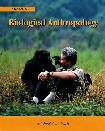1.Biological Anthropology
In the Field: Doing Biological Anthropology
What Is Biological Anthropology?
Bioanthropology and Science
Contemporary Reflections:Is Evolution a Fact, A Theory, or
Just a Hypothesis?2.The Evolution of Evolution
"On the Shoulders of Giants": Explaining the Changing Earth
"Common Sense at Its Best": Explaining Biological Change
Contemporary Reflections: Has Science Dehumanized
Society?3.Evolutionary Genetics
How Genes Work
From Gene to Trait
How Inheritance Works
Contemporary Reflections: What Does the Decoding of the
Human Genome Mean?
4.The Processes of Evolution
Species: The Units of Evolution
Mutations: Necessary Errors
Natural Selection: The Prime Mover of Evolution
Gene Flow: Mixing Populations
Genetic Drift: Random Evolution
Sickle Cell Anemia: Evolutionary Processes in Action
Contemporary Reflections: Are Humans Still Evolving?5.The Origin of Species and the Shape of Evolution
New Species
Adaptive Radiation: The Evolution of Life's Diversity
The Shape of the Family Tree
Evolution Questioned: The Pseudoscience of "Scientific
Creationism"
Contemporary Reflections: Can We See Evolution in Action?6.A Brief Evolutionary Timetable
From the Beginning: A Quick History
Drifting Continents and Mass Extinctions: The Pace of Change
7.The Primates
Naming the Animals
What Is a Primate?
A Survey of the Living Primates
The Human Primate
Contemporary Reflections: Should Nonhuman Primates
Have Rights?8.Primate Behavior and Human Evolution
Studying Behavior
Baboons
Chimpanzees
Bonobos
Contemporary Reflections: Are Some Human Behaviors
Genetic?9.Studying the Human Past
Bones: The Primate Skeleton
Old Bones: Locating, Recovering, and Dating Fossils
How Fossils Get to Be Fossils
Genes: New Windows to the Past
Contemporary Reflections: Who Owns Old Bones?10.Evolution of the Hominids
The Origin and Evolution of the Primates
The First Hominids: The Bipedal Primate
Bipedalism
The Hominids Evolve
The First Members of Genus Homo
Contemporary Reflections: Where Is the "Missing Link"?
11.The Evolution of the Genus Homo
Lumpers and Splitters: An Organizing Plan
To New Lands
Big Brains, Archaic Skulls
The Neandertals
Modern Humans
Contemporary Reflections: What Do We Mean by "Human"?
12.The Debate Over Modern Human Origins
The Models
The Evidence
Contemporary Reflections: Is There a Connection Between
Modern Human Origins and Race?13.The Study of Living Peoples
Genes in Populations
Evolution in Populations
Describing Populations
Human Adaptations
Disease and Human Populations
The Bioanthropology of Individuals
Contemporary Reflections: Where Is the Population Crisis?14 Human Biological Diversity
Sex and Gender
Race as a Biological Concept
Why Are There No Biological Races Within the Human
Species?
What, Then, Are Human Races?
Race, Bioanthropology, and Social Issues
Contemporary Reflections: Are There Racial Differences in
Athletic Ability?
15 Biological Anthropology and Today's World
Forensic Anthropology: Reading the Bones
Lessons from the Past
Bioanthropology and Global Issues
Contemporary Reflections: What Can One Do with a Degree
in Bioanthropology?
Appendix: Exercises in Biological Anthropology Glossary of Human and Nonhuman Primates Glossary of Terms Bibliography Index At the end of each chapter:
- Summary
- Key Terms
- Questions for Further Thought
- Suggested Readings
|



 2002 McGraw-Hill Higher Education
2002 McGraw-Hill Higher Education

 2002 McGraw-Hill Higher Education
2002 McGraw-Hill Higher Education